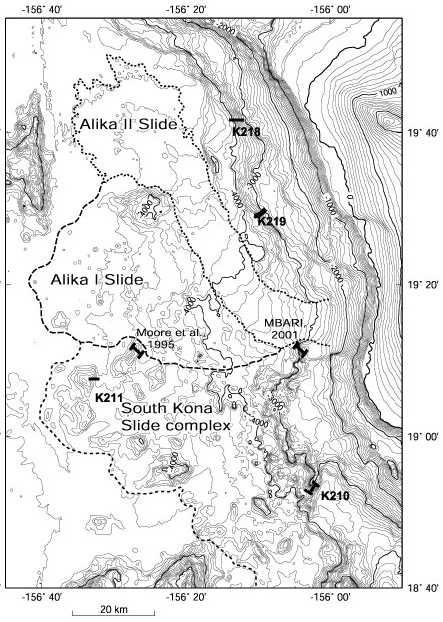2-5. South Kona Slide Complex [P Lipman]
Studies on the west (Mauna Loa side) of Hawaii
Island, where there are multiple young landslide
features (especially South Kona and Alika),
can provide counterparts to compare and contrast
with the existing detailed Hilina and Nu’uanu
results. The large distal blocks of the South
Kona landslide have never been systematically
sampled. The deeper parts of several of them
provide exceptional places to search for
lavas that may extend our view of Mauna Loa
magmatism back in time. This would provide
new views on the evolution of the Hawaiian
plume. Evidence may also be obtained on the
relative proportions of pillow lava vs hyaloclastite
involved in construction of the submarine
flanks of large oceanic-island volcanoes,
a current topic of controversy.
The South Kona landslide complex (Fig. 2-5-1)
involves multiple ages and styles of slope
failure. It includes three major morphologic
elements: (1) several geometrically intricate
proximal mid-slope benches and basins, (2)
a mid-distance field of many intermediate-size
(mostly <2 km) isolated blocks, and (3)
a distal region containing eight large blocks
(up to 10 km across and 500 m high). This
slide complex was originally recognized during
the USGS GLORIA side-scan surveys, and an
analogy was made between the mid-slope bench
and the Hilina slump (Lipman et al., 1988),
but detailed SeaBeam bathymetry was not available
until more recently. Dredging of two distal
blocks in 1991 brought up pillowed tholeiitic
lava, and observations during a dive with
the submersible SEA CLIFF in 1995 disclosed
massive fractured rocks interpreted as basalt,
overlain by hyaloclastite and pillow lava
(Moore et al., 1995). No samples were obtained
during the single dive, however, because
of manipulator malfunction. Several dives
by the Monterey Bay Aquarium Research Institute
(MBARI) were carried out just north of the
mid-slope bench in May 2001, but no results
are yet available.
 (Fig.2-5-1)
(Fig.2-5-1)
Analyses of glass from dredged samples have
compositions similar to modern Mauna Loa,
and Moore et al. interpreted the distal blocks
as emplaced by a long-traveled landslide
from this volcano before growth of the mid-slope
benches by later slump movement. No direct
visual observations or samples have previously
been obtained from the mid-slope benches,
however, nor have in-place samples been collected
from any of the distal blocks. Various alternative
interpretations seem possible. Rocks described
(but not sampled) during the SEA CLIFF dive
as “massive basalt (possibly intrusive and
intensely fractured)” (Moore et al., 1995,
p. 126) may alternatively constitute massive
turbidite sandstone, such as widely exposed
on the Hilina lower scarp. Rather than slump
blocks, the mid-slope benches may alternatively
represent toes of volcano flank that were
compressed and uplifted b y oceanward spreading
on the west slope of Mauna Loa. The sequence
of landslides and the lithologic succession
on the mid-slope benches, if studied in detail,
may provide critical information on (1) the
early growth of Mauna Loa, (2) any possible
involvement of rocks from Hualalai volcano,
and (3) frequency of large submarine landslides
from the largest volcanic edifice in the
world.
The 2001 KAIKO dives were designed to provide
pilot information on the feasibility of such
studies. One dive (K210) traversed an 1100
m section up the mid-slope bench, and a second
dive (K211) a previously unexplored outlying
distal block (Fig. 2-5-1). The resulting
video images and in-places samples, when
adequately analyzed, should provide important
information on the primary volcanic sources
(compositional comparisons with young Mauna
Loa) and eruption environment (subaerial
vs. submarine).


(Fig.2-5-1)